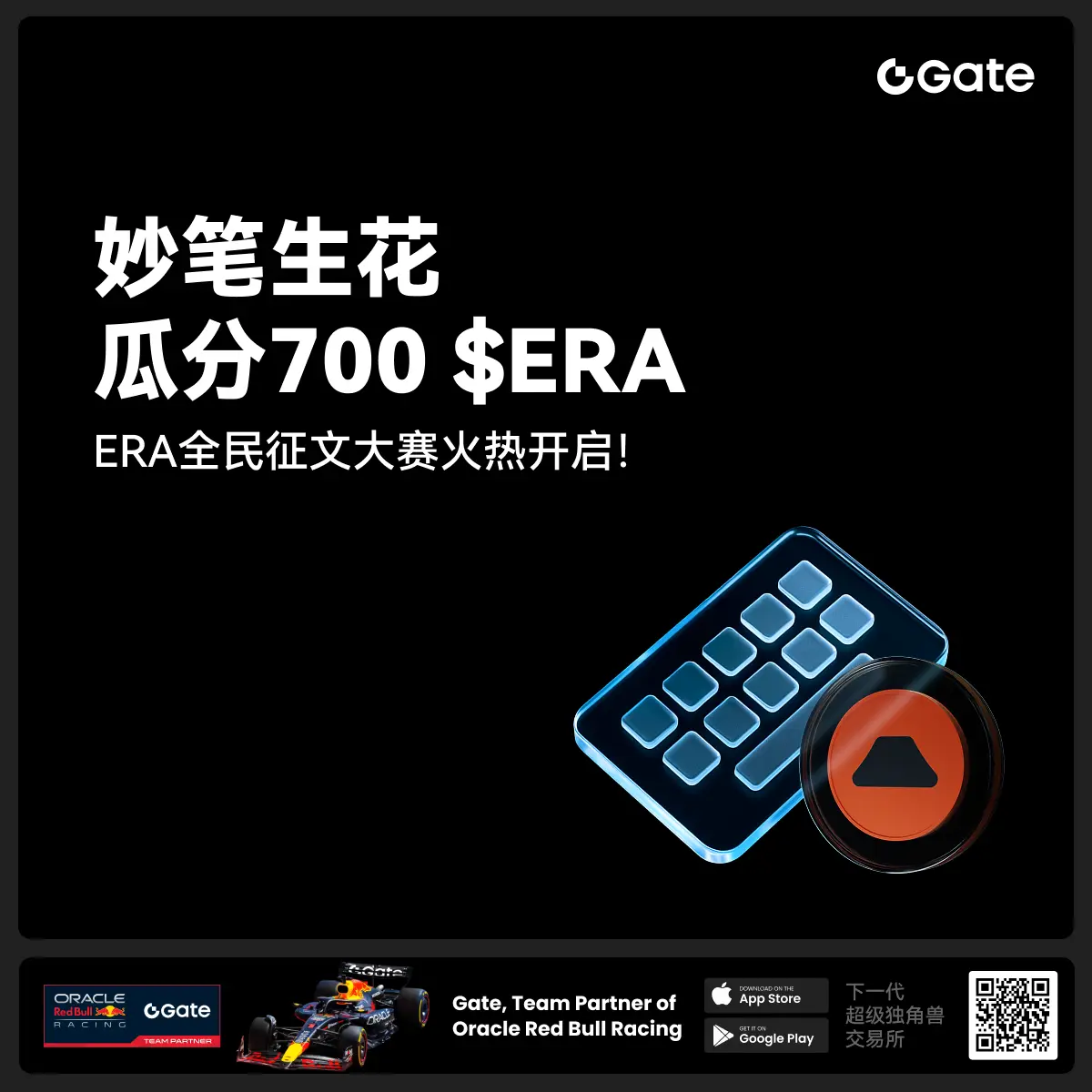- 話題1/3
13k 熱度
23k 熱度
18k 熱度
51k 熱度
24k 熱度
- 置頂
- 📢 Gate廣場 #MBG任务挑战# 發帖贏大獎活動火熱開啓!
想要瓜分1,000枚MBG?現在就來參與,展示你的洞察與實操,成爲MBG推廣達人!
💰️ 本期將評選出20位優質發帖用戶,每人可輕鬆獲得50枚MBG!
如何參與:
1️⃣ 調研MBG項目
對MBG的基本面、社區治理、發展目標、代幣經濟模型等方面進行研究,分享你對項目的深度研究。
2️⃣ 參與並分享真實體驗
參與MBG相關活動(包括CandyDrop、Launchpool或現貨交易),並曬出你的參與截圖、收益圖或實用教程。可以是收益展示、簡明易懂的新手攻略、小竅門,也可以是現貨行情點位分析,內容詳實優先。
3️⃣ 鼓勵帶新互動
如果你的帖子吸引到他人參與活動,或者有好友評論“已參與/已交易”,將大幅提升你的獲獎概率!
MBG熱門活動(帖文需附下列活動連結):
Gate第287期Launchpool:MBG — 質押ETH、MBG即可免費瓜分112,500 MBG,每小時領取獎勵!參與攻略見公告:https://www.gate.com/announcements/article/46230
Gate CandyDrop第55期:CandyDrop x MBG — 通過首次交易、交易MBG、邀請好友註冊交易即可分187,500 MBG!參與攻略見公告:https://www.gate.com/announcements
- 🎉 Gate廣場“星火計劃”入駐KOL突破1000人!
💥 創作者生態迎來全面爆發期!
📈 上首頁、拿獎勵、贏影響力,你還在等什麼?
💰 現金激勵 ✔️
🚀 流量扶持 ✔️
👑 專屬認證 ✔️
從0到1000,我們只用了短短數周,Gate廣場正在成爲Web3內容風暴眼⚡
你發布的不只是內容,而是下一個“爆款機會”!
🌟 加入星火計劃,開啓你的爆發之路!
👉 https://www.gate.com/announcements/article/45695
#GateSquare # #星火计划# #内容创作者新纪元 # #KOL集结令#
- 📢 #Gate广场征文活动第三期# 正式啓動!
🎮 本期聚焦:Yooldo Games (ESPORTS)
✍️ 分享獨特見解 + 參與互動推廣,若同步參與 Gate 第 286 期 Launchpool、CandyDrop 或 Alpha 活動,即可獲得任意獎勵資格!
💡 內容創作 + 空投參與 = 雙重加分,大獎候選人就是你!
💰總獎池:4,464 枚 $ESPORTS
🏆 一等獎(1名):964 枚
🥈 二等獎(5名):每人 400 枚
🥉 三等獎(10名):每人 150 枚
🚀 參與方式:
在 Gate廣場發布不少於 300 字的原創文章
添加標籤: #Gate广场征文活动第三期#
每篇文章需 ≥3 個互動(點讚 / 評論 / 轉發)
發布參與 Launchpool / CandyDrop / Alpha 任一活動的截圖,作爲獲獎資格憑證
同步轉發至 X(推特)可增加獲獎概率,標籤:#GateSquare 👉 https://www.gate.com/questionnaire/6907
🎯 雙倍獎勵機會:參與第 286 期 Launchpool!
質押 BTC 或 ESPORTS,瓜分 803,571 枚 $ESPORTS,每小時發放
時間:7 月 21 日 20:00 – 7 月 25 日 20:00(UTC+8)
🧠 寫作方向建議:
Yooldo
- 🎉Gate 2025 上半年社區盛典:內容達人評選投票火熱進行中 🎉
🏆 誰將成爲前十位 #Gate广场# 內容達人?
投票現已開啓,選出你的心頭好
🎁贏取 iPhone 16 Pro Max、限量週邊等好禮!
📅投票截止:8 月 15 日 10:00(UTC+8)
立即投票: https://www.gate.com/activities/community-vote
活動詳情: https://www.gate.com/announcements/article/45974
- 📢 #Gate广场征文活动第二期# 正式啓動!
分享你對 $ERA 項目的獨特觀點,推廣ERA上線活動, 700 $ERA 等你來贏!
💰 獎勵:
一等獎(1名): 100枚 $ERA
二等獎(5名): 每人 60 枚 $ERA
三等獎(10名): 每人 30 枚 $ERA
👉 參與方式:
1.在 Gate廣場發布你對 ERA 項目的獨到見解貼文
2.在貼文中添加標籤: #Gate广场征文活动第二期# ,貼文字數不低於300字
3.將你的文章或觀點同步到X,加上標籤:Gate Square 和 ERA
4.徵文內容涵蓋但不限於以下創作方向:
ERA 項目亮點:作爲區塊鏈基礎設施公司,ERA 擁有哪些核心優勢?
ERA 代幣經濟模型:如何保障代幣的長期價值及生態可持續發展?
參與並推廣 Gate x Caldera (ERA) 生態周活動。點擊查看活動詳情:https://www.gate.com/announcements/article/46169。
歡迎圍繞上述主題,或從其他獨特視角提出您的見解與建議。
⚠️ 活動要求:
原創內容,至少 300 字, 重復或抄襲內容將被淘汰。
不得使用 #Gate广场征文活动第二期# 和 #ERA# 以外的任何標籤。
每篇文章必須獲得 至少3個互動,否則無法獲得獎勵
鼓勵圖文並茂、深度分析,觀點獨到。
⏰ 活動時間:2025年7月20日 17
SXT 再獲微軟力挺,數據敘事潛力如何
撰文:Bright,Foresight News
5 月 20 日晚,微軟被曝正在通過與加密初創公司 Space and Time Labs (SXT) 合作,將新的區塊鏈數據源集成到其 Fabric 分析平台。Space and Time 將在 Microsoft Azure OneLake 平台上爲 Fabric 用戶提供比特幣、Sui 和以太坊的“實時、可驗證”數據源,這是一種提供單一雲存儲帳戶的“數據 OneDrive”。
Space and Time(SXT )是一個基於零知識證明(ZK)的去中心化數據庫項目,旨在解決區塊鏈智能合約的數據處理難題。其核心技術是 Proof of SQL 協議,通過將鏈上(如以太坊、比特幣)和鏈下(如傳統數據庫、IoT 數據)的多元數據統一存儲爲 SQL 兼容的結構化表格,允許開發者用標準 SQL 語句查詢數據,並生成零知識證明驗證結果的正確性和完整性。
SXT 由微軟 M12 基金兩次投資(2022 年領投 2000 萬美元,2024 年參與 A 輪 2000 萬美元),並與幣安、Chainlink 等平台合作,2025 年 5 月先後幣安 launchpool、幣安 alpha,並爲 Chainlink 質押者和幣安 alpha 用戶進行了空投。
解決鏈上,更橋接現實
當前區塊鏈智能合約面臨四大數據困境:跨鏈數據難獲取、復雜查詢無工具、ZK 證明速度慢、預言機中心化風險。去中心化數據索引協議的老前輩 The Graph(GRT)注重解決鏈上數據的查詢效率問題。其通過激勵節點(索引者)將以太坊、Polygon 等公鏈的原始數據(如交易、合約事件)提取並結構化處理爲可查詢的 API 接口(Subgraphs),開發者可通過 GraphQL 語言快速調取鏈上信息。但其功能邊界的局限極爲現實:僅支持鏈上數據,不涉及鏈下或跨鏈整合,且缺乏對查詢結果的加密驗證機制,數據可信度依賴節點經濟約束等。
SXT 鏈以 Proof of SQL 協議爲核心,解決了一些區塊鏈原生的數據處理問題,更引入了現實世界的數據處理能力:
例如,亞秒級 ZK 證明。STX 支持標準 SQL 語法(JOIN、GROUP BY、時序分析等),可處理跨鏈數據關聯(如「地址 A 在 ETH/BSC/zkSync 的總質押量」)與歷史趨勢分析(如「過去 30 天某 DEX 交易量波動原因」),並宣布採用 GPU 加速,生成對應的 zk-SNARK 證明僅需 “亞秒級”,速度遠優於傳統 zkVM 生成的數十秒 。而且 STX 還支持 100GB 級數據查詢,實現 “鏈上數據秒級驗證”。
還有,SQL 查詢自由。STX 將以太坊、比特幣等鏈上數據轉化爲 SQL 兼容表結構,還支持鏈下數據源(SQL 數據庫、API、IoT 流)的接入與跨鏈整合。例如,可將某企業的鏈下銷售數據與鏈上交易記錄同步存儲,形成統一數據集。開發者可直接用 SQL 語句查詢歷史交易、跨鏈資產等復雜數據,無需依賴中心化預言機.
此外,STX 的三層節點架構也有其巧思。索引節點從主流公鏈提取數據並結構化存儲,質押 SXT 確保數據真實,作惡即罰沒代幣;證明節點處理查詢請求並生成 ZK 證明,性能是傳統方案的 “數量級突破”;驗證者通過 BFT 共識維護數據不可篡改性,確保鏈上承諾與底層數據一致。
微軟投資,多元應用
SXT 鏈的出現再次滿足了多元應用場景的想象。或許,這也是 SXT 連續獲得微軟 M12 基金的投資(2022 年領投 2000 萬美元,2024 年參與 2000 萬美元 A 輪)的原因
在 DeFi 領域,可實時分析用戶多鏈資產動態調整借貸利率,或跨鏈整合用戶資產與協議健康度數據支持復雜衍生品;企業級場景中,FTI Consulting 等機構用其生成防篡改審計報告,滿足 SEC 等監管要求,物聯網等強審計需求行業則可借助 SXT 進一步確保數據完整性;AI 領域則可結合鏈上數據與 Azure OpenAI 訓練可信模型,例如預測市場趨勢的智能交易機器人。在鏈遊場景中,鏈下遊戲事件可以導入 SXT 並附帶 ZK 證明發送至 NFT 智能合約,實現鏈上屬性進化(等級、皮膚、獎勵)。遊戲工作室可跨鏈分析玩家行爲與道具經濟,無需依賴中心化數據存儲。
而且數據鏈上貨幣化的遐想更有可能成爲現實。當一個數據集被查詢,發布主體即可獲得 SXT 代幣獎勵。同時也鼓勵了多方共同貢獻並查詢共享數據,爲設立去信任化的數據庫聯盟創造了便利條件。
代幣經濟學方面,50 億枚 $SXT 總量中超 50% 歸屬社區,用於激勵節點質押、數據提供和開發者生態,質押者可獲年化收益,數據發布者按查詢量分成。
盡管面臨技術落地與監管合規挑戰,SXT 鏈憑藉微軟背書+Chainlink 支持,以自身 “可信數據 + SQL 查詢” 的差異化定位,還是有望成爲 Web3 數據基礎設施的核心層,推動區塊鏈從金融應用向企業級數據服務擴展。